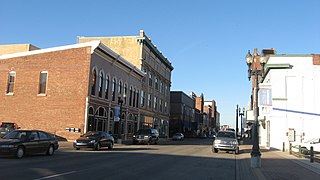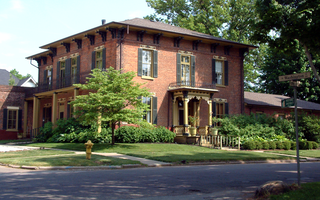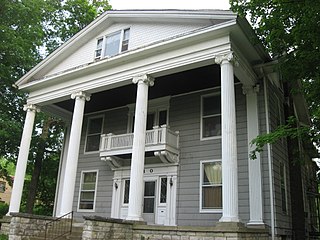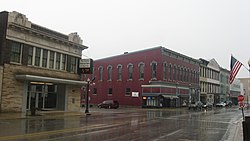
The Elwood Downtown Historic District is a national historic district located at Elwood, Madison County, Indiana. The district encompasses 51 contributing buildings and 1 contributing object in the central business district of Elwood. It developed between about 1887 and 1952, and includes notable examples of Late Victorian, Romanesque Revival, Neoclassical, and Art Deco style architecture. Notable buildings include the Calloway Block, Dehority Block (1894), St. Joseph Catholic Church (1899), United Methodist Church (1899), U.S. Post Office (1911), Carnegie Library (1901), former Elwood City Hall (1899), the Leeson's Building, and the Opera House.

The Greensburg Downtown Historic District is a national historic district located at Greensburg, Decatur County, Indiana. It encompasses 67 contributing buildings and 3 contributing objects in the central business district of Greensburg. The district developed between about 1854 and 1945, and includes notable examples of Italianate, Queen Anne, and Classical Revival style architecture. Located in the district are the separately listed Decatur County Courthouse and Knights of Pythias Building and Theatre. Other notable buildings include the Palmer Building, YMCA (1915), City Hall (1874), U.S Post Office, George E. Erdmann Building (1908),.

Hope Historic District is a 114-acre (46 ha) national historic district located at Hope, Bartholomew County, Indiana. It encompasses 205 contributing buildings, four contributing sites and two contributing objects in the central business district and surrounding residential areas of Hope. It was developed between about 1840 and 1940, includes works by architect Elmer E. Dunlap and by L.W. Weisner, and notable examples of Greek Revival, Italianate, Hall and parlor, and other architecture. Notable buildings include the Moravian Church (1875) and old parsonage (1875), City School (1906), Baptist Church, Methodist Episcopal Church (1887), Alfred Sanford Rominger House, Frank Stapp House, Masonic Temple (1910), and E.B. Spaugh Building (1915).

The Richmond Downtown Historic District is an area of primarily commercial buildings and national historic district located at Richmond, Wayne County, Indiana. The district encompasses 47 contributing buildings located along the National Road. It developed between about 1868 and 1960 and includes representative examples of Italianate, Romanesque Revival, Queen Anne, Classical Revival, and Chicago School style architecture. Located in the district is the separately listed Murray Theater. Other notable buildings include the I.O.O.F. Building (1868), Hittle Building (1878), Tivoli Theater (1926), Romey's Building (1920), George H. Knollenberg Building (1877), Kresge Building, Dickinson Building (1880), former U.S. Post Office (1905), and YMCA (1908).

Brazil Downtown Historic District is a national historic district located at Brazil, Clay County, Indiana. The district encompasses 35 contributing buildings and two contributing objects in the central business district of Brazil. The district developed between about 1875 and 1935, and includes notable examples of Italianate, Romanesque Revival, and Renaissance Revival style architecture. Located in the district is the separately listed United States Post Office. Other notable buildings include the Sinclair Oil Gas Station, Lark Theater, Citizens Bank Building, Brazil Trust Company, D.H. Davis Building (1909), and Telephone Building.

Downtown Aurora Historic District is a national historic district located at Aurora, Dearborn County, Indiana. The district encompasses 272 contributing buildings, 1 contributing site, and 3 contributing structures in the central business district of Aurora. The district developed between about 1830 and 1944, and includes notable examples of Italianate, Federal, and Greek Revival style architecture. Located in the district are the separately listed Aurora City Hall, Aurora Methodist Episcopal Church, Aurora Public Library, First Evangelical United Church of Christ, First Presbyterian Church, George Street Bridge, Hillforest, Lewis Hurlbert, Sr. House, Leive, Parks and Stapp Opera House, and George Sutton Medical Office. Other notable buildings include the T. and J.W. Gaff Distillery (1843), First National Bank (1924), I.O.O.F. Hall (1887), B&O Railroad Station (1911-1917), John Neff Building, Chamber Stevens & Co. Dry Goods Store, U.S. Post Office (1935), Star Milling Co. (1891), and St. John's Evangelical Lutheran Church (1874).

Downtown Lawrenceburg Historic District is a national historic district located at Lawrenceburg, Dearborn County, Indiana. The district encompasses 257 contributing buildings and 2 contributing objects in the central business district and surrounding residential sections of Lawrenceburg. The district developed between about 1815 and 1900, and includes notable examples of Late Victorian, Federal, and Greek Revival style architecture. Located in the district are the separately listed Dearborn County Courthouse and Hamline Chapel United Methodist Church. Other notable buildings include the Trade and Industrial Building (1881), Lawrenceburg Theater (1875), Jesse Hunt Hotel (1818), the birthplaces of James B. Eads and Louis Skidmore.

Downtown Auburn Historic District is a national historic district located at Auburn, DeKalb County, Indiana. The district encompasses 52 contributing buildings in the central business district of Auburn. The district developed between about 1870 and 1935, and includes notable examples of Victorian, Classical Revival, Romanesque Revival, and Colonial Revival style architecture. Notable buildings include the DeKalb County Courthouse (1911-1914), Henry Opera House (1917), DeKalb County Jail (1918), Commercial Club (1917), Auburn City Hall (1913), South Interurban Station, Dilgard Building, Y.M.C.A. Building (193-1914), Auburn Hotel (1922), U.S. Post Office (1934), and Masonic Temple.

Walnut Street Historic District is a national historic district located at Muncie, Delaware County, Indiana. It encompasses 66 contributing buildings and 1 contributing object, and is located in the central business district of Muncie. The district includes notable examples of Italianate, Late Victorian, Colonial Revival, and Beaux-Arts style architecture. Located in the district are the separately listed Moore-Youse-Maxon House, Roberts Hotel, and Goddard Warehouse. Other notable buildings include the Patterson Bock, McNaughton Block (1901-1903), Mitchell Block (1909), American National Bank Building (1924), Marsh Block (1888), and the Old Post Office designed by the Office of the Supervising Architect under James Knox Taylor.

Elkhart Downtown Commercial Historic District is a national historic district located at Elkhart, Elkhart County, Indiana. The district encompasses 59 contributing buildings in the central business district of Elkhart. It was developed between about 1868 and 1930, and includes notable examples of Italianate, Queen Anne, and Classical Revival style architecture. Located in the district are the separately listed Green Block, Lerner Theatre, and Young Women's Christian Association. Other notable buildings include the Cornish Block, Franklin Street Station (1895), Menges Building (1908), former Post Office (1905), Midwest Museum of Modern Art (1922), Elkhart Water Company, Masonic Temple, Rowe Block (1900), and Dreves Building.

Downtown Nappanee Historic District is a national historic district located at Nappanee, Elkhart County, Indiana. The district encompasses 26 contributing buildings in the central business district of Nappanee. It was developed between about 1874 and 1939, and includes notable examples of Italianate and Classical Revival style architecture. Notable buildings include the Bechtel Building (1888), U.S. Post Office, Dietrich Block, Kaufman's Department Store (1902), First National Bank, Yoder's Garage, B&O Depot, Hartman Brothers Building, and Farmers and Traders Bank (1915).

Attica Main Street Historic District is a national historic district located at Attica, Fountain County, Indiana. The district encompasses 36 contributing buildings, 1 contributing site, and 2 contributing structures in a predominantly residential section of Attica. It developed between about 1840 and 1940, and includes notable examples of Late Victorian, Greek Revival, and Federal style architecture. Located in the district is the separately listed Marshall M. Milford House. Other notable contributing resources include McDonald Park, Parker-Clark House, Attica Presbyterian Church (1849), Ziegler House, Rolphing-Colvert Home, "Ladies Library" (1889), former Church of Christ (1891), and Attica Methodist Church (1921).

Brady Street Historic District is a national historic district in Attica, Fountain County, Indiana. The district encompasses 108 contributing buildings, 9 contributing structures, and 4 contributing objects in a predominantly residential section of Attica. It developed between about 1840 and 1930, and includes notable examples of Greek Revival, Gothic Revival, and Italian Villa style architecture. Notable contributing buildings include the Carnegie library (1904), Schlosser House (1840s), Catholic Church (1891) and rectory (1895), McClaflin House (1904), and Greenwood House (1877).

Old East Historic District is a national historic district located at Attica, Fountain County, Indiana. The district encompasses 43 contributing buildings and 2 contributing structures in a predominantly residential section of Attica. It developed between about 1865 and 1930, and includes notable examples of Late Victorian, Tudor Revival, and Italian Villa style architecture. Notable contributing buildings include the Holmes House (1877), Meharry House (1908), Colvert House (1901), and McDermond House (1897).

Marion Downtown Commercial Historic District is a national historic district located at Marion, Grant County, Indiana. It encompasses 52 contributing buildings, 2 contributing structures, and 1 contributing object in the central business district of Marion. It developed between about 1870 and 1942, and includes notable examples of Italianate, Romanesque, and Classical Revival style architecture. Located in the district is the separately listed Grant County Jail and Sheriff's Residence. Other notable buildings are the Grant County Courthouse (1881–1883), Marion Bank Building, Iroquois Building, Dan-Mar Apartments, United Telephone Block, Cecelian Apartments, Marion Post Office, and William Smith Building / Mecca Club.

Sheridan Downtown Commercial Historic District is a national historic district located at Sheridan, Hamilton County, Indiana. It encompasses 38 contributing buildings and 1 contributing structure in the central business district of Sheridan. It developed between about 1880 and 1939, and includes notable examples of Italianate and Romanesque Revival style architecture. Notable buildings include the H.J. Thistlethwaite Building (1886), Carnegie library, First Christian Church (1910-1911), Higbee Buggy Company, American State Bank (1914), Stanley Brothers Building, Slliot's Drugstore, Indiana Telephone Company building, and U.S. Post Office (1939-1940).

Ellettsville Downtown Historic District is a national historic district located at Ellettsville, Monroe County, Indiana. The district encompasses 50 contributing buildings in the central business district and surrounding residential sections of Ellettsville. It developed between about 1840 and 1953, and includes notable examples of Queen Anne, Early Commercial, Gothic Revival, and Bungalow/American Craftsman style architecture. Notable buildings include the Robert Stimson House, May Presley House, Bradford House, George W. Fletcher House, Wickens House (1909), Capt. Gilbert Perry House, I.O.O.F. Building, Town Hall (1927), Masonic Building (1895), Knights of Pythias Building, First United Methodist Church (1900), and First Baptist Church (1909).

Eastern Enlargement Historic District is a national historic district located at Greencastle, Putnam County, Indiana. The district encompasses 272 contributing buildings in a predominantly residential section of Greencastle. The district developed between about 1840 and 1961 and includes notable examples of Greek Revival, Gothic Revival, Italianate, Queen Anne, Stick Style, and Bungalow / American Craftsman style architecture. Located in the district are the separately listed Delta Kappa Epsilon Fraternity, F.P. Nelson House and William C. Van Arsdel House. Other notable buildings include the Braman House (1840), James B. Nelson House, O'Hair House, John Ireland House, and a number of fraternity and sorority houses associated with DePauw University.

Farmland Downtown Historic District is a national historic district located at Farmland, Randolph County, Indiana.

Downtown Wabash Historic District, also known as the Wabash Marketplace District, is a national historic district located at Wabash, Wabash County, Indiana. It encompasses 27 contributing buildings in the central business district of Wabash. It developed between about 1840 and 1920, and includes representative examples of Italianate, Romanesque Revival, and Second Empire style architecture. Located in the district are the separately listed James M. Amoss Building and Solomon Wilson Building. Other notable buildings include the E.M. Conner Building (1897), Back Saddlery and Harness Shop (1845), Wabash Loan and Trust Company (1927), Bradley Block (1901), Busick Block (1882), Eagles Building (1906), the Plain Dealer Building (1897), S.J. Payne Block (1898), J.C. Penney's (1920), National Block (1876), Sheriff's House and Jail (1879), Memorial Hall (1899), U.S. Post Office (1911-1912), Wabash County Courthouse (1878), Shively Block (1897), and Wabash City Hall (1883-1884).

























